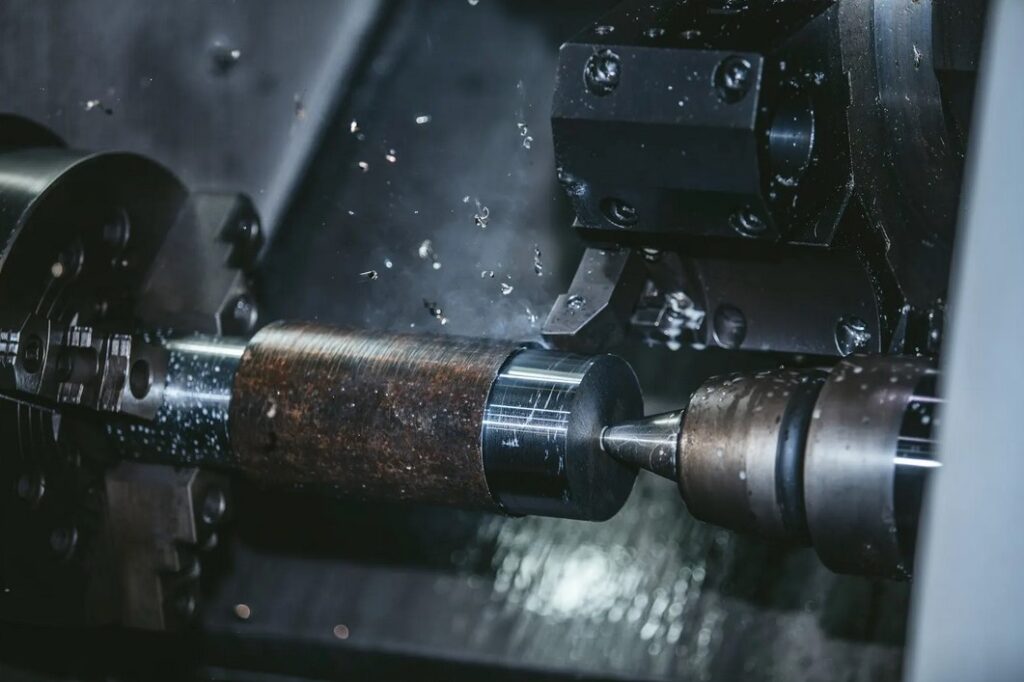
7 Game-Changing Tips for Better Lathe Work with Revolving Centres and Dead Centres
Before diving into details let’s have a quick check. If your goal in machining projects is to:
- Support heavy workpieces
- Enhance work safety
- Achieve tighter tolerances, smoother finishes, and faster cycle times
Then a high-performance revolving center is the foundation for maximising your lathe’s potential!
Investing in the right revolving centre is the critical link to determining the efficiency, precision, and longevity of your work.
Let’s check out this guide to discover their importance, how they enhance various turning tools, and provide practical tips for optimal utilisation.
Understanding Your Turning Tools & The Revolving Center Advantage
Before diving into the specifics of revolving centers, let’s briefly overview the key turning tools used in lathe operations.
Precision machining and flawless metalworking on a lathe are impossible without a reliable center. This critical component acts as the steadfast support system for your rotating workpiece.
There are two key types that dominate which are:
1. Live Centers
Lathes and similar machine tools employ centers to provide stable support for workpieces, typically positioned between the headstock and tailstock [1].
The key distinction lies in their movement where live centres incorporate bearings that allow them to rotate with the part being machined.
This drastically reduces friction and wear – a must-have for substantial or long workpieces.
Within this category there’s more variety you can choose from based on your specific needs. These vary from:
| Live Centre Types | Description | Typical Applications | Advantages |
|---|---|---|---|
Standard Live Center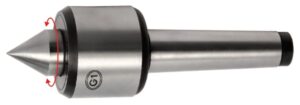 | Contains internal bearings (ball or roller) allowing it to rotate with the workpiece. | Medium to high-speed turning of various materials. General-purpose use where reduced friction is beneficial. | Reduced friction and heat generation, allows for higher spindle speeds and feed rates, improved surface finish, longer tool life compared to dead centers. |
Live Centre Types | A live center specifically engineered with high-quality, precision bearings and often a balanced design for optimal performance at high RPMs. | Machining operations requiring high spindle speeds, often used with modern CNC lathes for increased productivity and efficiency. Suitable for various materials depending on the specific design and tip material. | Maintains accuracy and smooth rotation at high speeds, reduces vibration and runout, often features enhanced sealing for longer bearing life, allows for efficient high-speed machining. |
Live Centre Types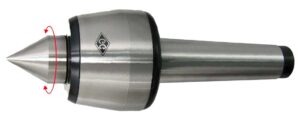 | Similar to a standard live center but with a carbide insert at the contact point for increased wear resistance. | High-speed turning, heavy-duty applications, and machining of abrasive materials. Ideal for longer production runs. | Excellent wear resistance, maintains accuracy under heavy loads and high speeds, extended lifespan, suitable for demanding materials. |
2. Dead Centers
Similar to live centers, dead centers rely on pre-drilled holes at each end of the workpiece for secure engagement.
The key difference lies in their construction: lacking internal bearings, dead centers typically do not rotate with the workpiece, except when directly fitted into the spindle nose.
Your project’s requirements will dictate the optimal choice. Ultimately, a dependable lathe center is a direct investment in accuracy, reduced waste, and the pride of achieving superior final products.
Here’s a breakdown of the types of dead centres:
| Dead Centre Types | Description | Typical Applications | Advantages |
|---|---|---|---|
| Standard Dead Center | A hardened steel cone that is fixed and does not rotate. It requires lubrication at the contact point. | Low to medium speed turning of softer materials. General-purpose workholding. | Simple design, relatively inexpensive, high rigidity. |
| Carbide-Tipped Dead Center | Similar to a standard dead center but with a wear-resistant carbide insert at the contact point. | Higher speed turning, harder materials, and longer production runs where wear is a concern. | Increased wear resistance, longer lifespan compared to standard dead centers, maintains accuracy for longer periods. |
| Half Dead Center | A dead center with a portion of the cone ground away, providing clearance for facing operations. | Turning operations that require facing the end of the workpiece without interference from the center. | Allows for end facing without removing the workpiece from the centers, improving efficiency. |
For more selections on revolving centres for your machining project, check out these recommended models that may suit your needs!
![[Kota Cutting Tools] Blog Topic 6_Image 4](https://kotakct.com/wp-content/uploads/2025/08/Kota-Cutting-Tools-Blog-Topic-6_Image-4.jpg)
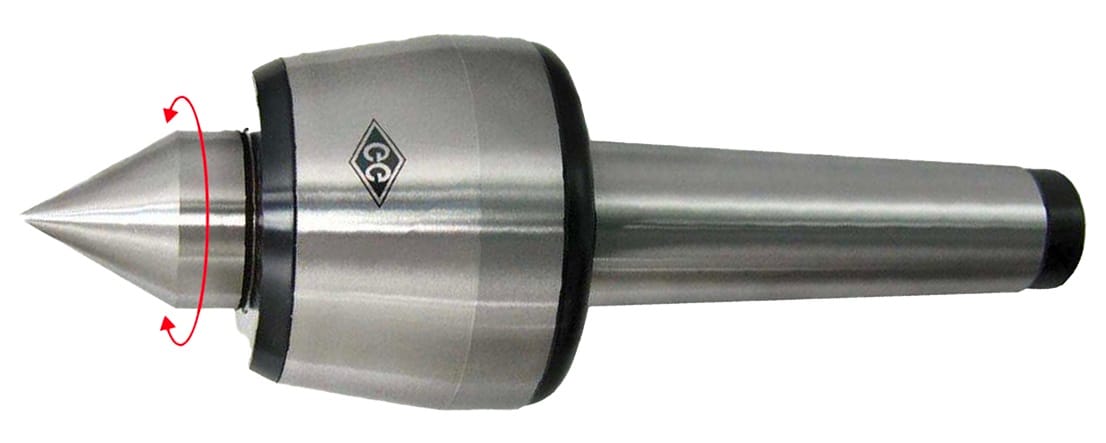
Premium Quality Cutting Tools at Competitive Prices
Our cutting tools are expertly manufactured and rigorously tested to enhance machining performance and operational savings.
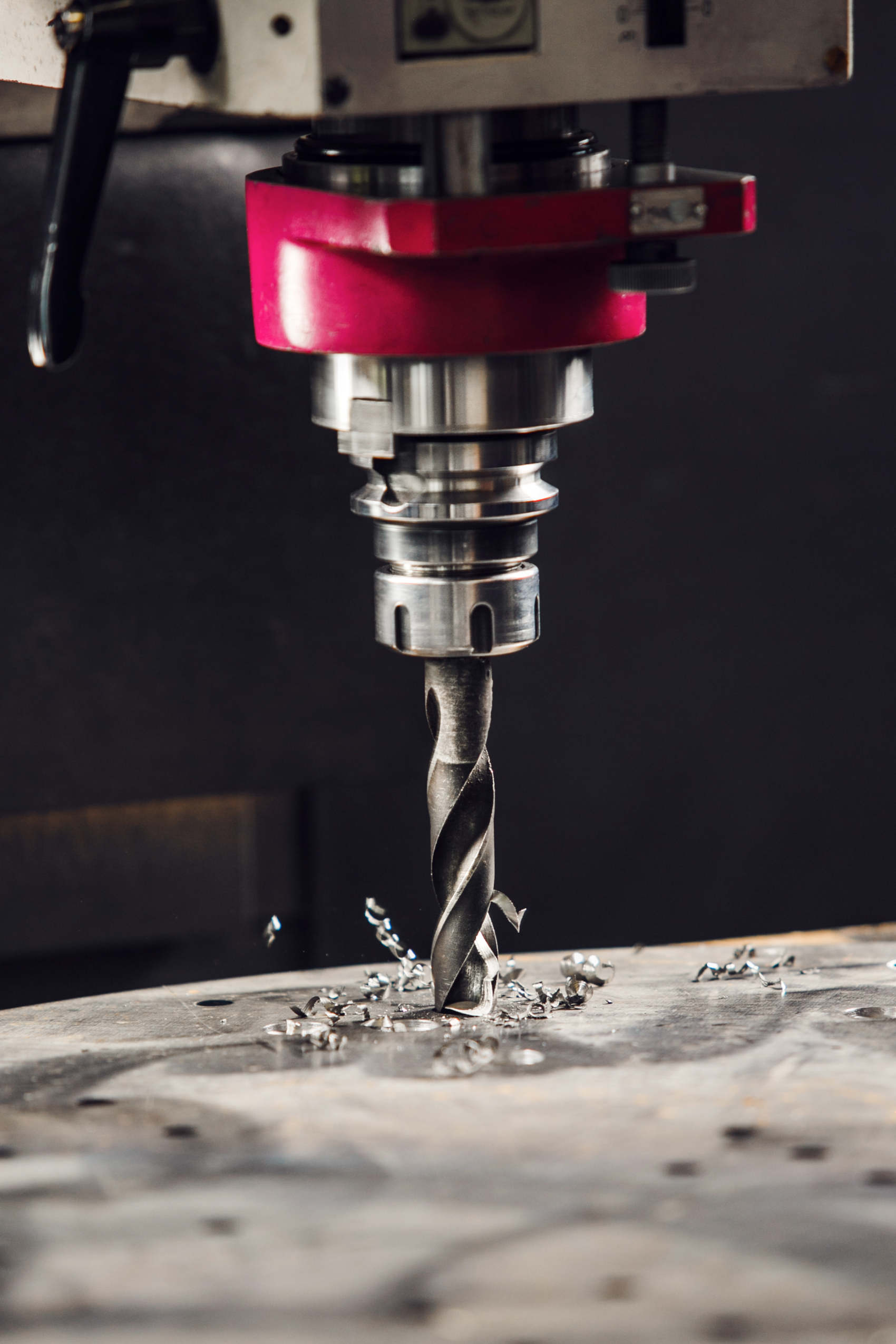
Selecting the Right Revolving Center for Optimal Results
The selection of a right revolving center isn’t just a detail; it’s central to unlocking your lathe’s peak performance! Picking the wrong one can leave your machining feeling a little… off-center.
So, let’s spin through the key factors to ensure you find the perfect partner for your turning endeavors:
1. Material Matters: Hard Heads Need Harder Support!
If you’re looking to machining soft materials like aluminum, brass, copper, and certain plastics A standard live center might just be your point man.
But when tackling tougher materials, carbide-tipped centers are the heavy hitters, offering the edge you need for long-lasting accuracy. They’re like the seasoned pros who can handle the pressure without losing their form.
2. Size and Weight: Don’t Let Your Workpiece Get You Down!
For lighter tasks, a standard live center can provide adequate support. However, when tackling heavier workpieces, it’s crucial to select a live center engineered with sufficient load-bearing capacity to maintain stability throughout the operation.
Pay close attention to the center’s specifications to ensure its performance doesn’t diminish under pressure.

80 Bull Head Live Centre (BP80)
For particularly bulky projects, consider utilising a bull nose live center, which features a broader contact surface to deliver enhanced stability and effectively minimise any potential for unwanted vibration or movement [2].
3. Going Fast (Responsibly)
When working at lower spindle speeds, a typical live center will generally perform adequately. However, if your operations demand high rotational speeds, investing in a high-speed live center is essential.
These specialised centers are engineered with precision bearings designed to withstand the increased friction and heat generated at higher RPMs, preventing premature failure. Think of them as the performance-tuned versions, built for rapid and reliable operation without compromising stability or longevity.
4. What’s Your Operation Station?
The demands of your turning operations should heavily influence your center selection. For aggressive roughing cuts, a sturdy center with a strong grip is paramount to withstand the forces involved.
Therefore, a heavy-duty revolving center emerges as the optimal solution, especially when combined with features like those detailed below, ensuring both robust performance and exceptional precision.
This type of center delivers:
- Unwavering accuracy, guaranteed to within 0.003mm TIR (0.0001”), providing the confidence needed for critical tolerances.
- Versatile excellence, equally adept on CNC and conventional machines, as well as excelling in demanding heavy-duty machining applications.
- Exceptional durability, thanks to its heat-treated point reaching HRc 60, promising longevity and resistance to wear.
- Unmatched performance, built upon a taper roller bearing assembly, ensuring smooth operation and the capacity to handle significant loads.
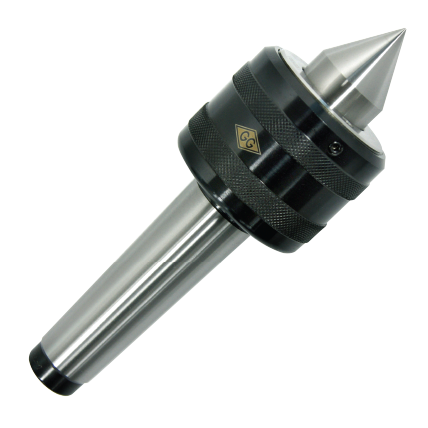
Additionally, if you occasionally require the rigidity of a dead center for facing operations, a half dead center can provide the necessary clearance without the complete inconvenience of a full center swap [3].
5. Taper Tantrums: It’s All About the Fit!
Ensuring a precise fit between your revolving center’s shank and your lathe’s tailstock Morse taper is absolutely critical.
This compatibility is non-negotiable for achieving stable and accurate workholding as any mismatch will inevitably lead to instability and an inability to properly center the workpiece, akin to forcing a square peg into a round hole – a recipe for frustration and compromised results.
Investing in top-notch live tools means investing in smoother operations, superior finishes, and a more well-rounded machining experience. Don’t let a subpar center be the Achilles’ heel of your turning process!
Check out Kota Cutting Tools’ whole rotation of revolving centers along with other items like threading dies, and drills for your projects.
7 Practical Tips for Enhanced Performance with Revolving Centers
![[Kota Cutting Tools] Blog Topic 6_Image 9](https://kotakct.com/wp-content/uploads/2025/08/Kota-Cutting-Tools-Blog-Topic-6_Image-9.jpg)
To truly unlock the potential of your lathe and achieve superior results with revolving centers, go beyond basic setup and implement these key practices:
1. Precision Centering: The Foundation of Accuracy
Before you even start cutting, take the time to meticulously center your workpiece between the headstock and tailstock [4]
This ensures that the cutting forces are evenly distributed, minimising the risk of vibration and preventing unwanted runout. Accurate centering is the bedrock of precise turning and a smooth machining process.
Want to see these principles in action? Watch this video to gain a clearer understanding of how to maximise accuracy with the right revolving center: How To Align The Tailstock To The Headstock On Your Lathe.
2. The Gentle Touch: Applying Optimal Tailstock Pressure
Finding the sweet spot for tailstock pressure is crucial. Apply enough force to provide firm and stable support, preventing the workpiece from shifting during machining.
However, avoid excessive pressure, which can overload the revolving center’s bearings, leading to premature wear and potential damage to delicate workpieces. A balanced approach ensures both stability and longevity.
3. Keep it Smooth: Consistent Lubrication is Key to Longevity
For your live centers, regular lubrication is key to maintaining their smooth and efficient operation. It is important that you follow the manufacturer’s guidelines for the recommended lubricant and lubrication intervals.
This proactive maintenance minimises friction within the bearings, reduces heat buildup, and significantly extends the lifespan of your investment, ensuring consistent performance over time.
4. Vigilant Inspection: Spotting Issues Before They Multiply
Make it a routine to inspect your revolving centers for any signs of wear, damage (like nicks or dents), or excessive runout. Addressing these issues promptly is vital. A worn or damaged center can introduce inaccuracies into your workpiece and even cause damage to your machine.
Early detection and replacement are key to maintaining quality and preventing more significant problems down the line.
5. A Clean Start: Ensuring Pristine Contact Surfaces
Before mounting your workpiece, always ensure that both the revolving center’s point and the center holes in your workpiece are thoroughly clean and free of any chips, dust, or debris.
Even small particles can impede proper contact, leading to slippage, vibration, and inaccuracies in your machining. A clean interface guarantees secure and stable support.
6. Match the Tool to the Task: Selecting the Right Center for Optimal Support
Don’t just grab any revolving center. Take the time to select the most appropriate type based on the specific demands of your material, the machining operation you’re performing, and the cutting parameters you’ll be using.
Choosing a carbide-tipped center for hardened steel or a bull nose center for a large diameter workpiece can make a significant difference in stability, accuracy, and efficiency.
7. Minimise the Leverage: Reducing Workpiece Overhang
When setting up your workpiece, strive to minimise the amount of material that extends beyond the support of the revolving center. Excessive overhang acts like a lever, amplifying vibrations and increasing the potential for deflection under cutting forces.
Reducing this overhang provides more rigid support and contributes to improved surface finishes and tighter tolerances.
CNC Lathe vs. CNC Turning Center
![[Kota Cutting Tools] Blog Topic 6_Image 10](https://kotakct.com/wp-content/uploads/2025/08/Kota-Cutting-Tools-Blog-Topic-6_Image-10.jpg)
When using revolving centres, choosing the right CNC machine for your turning needs can feel like navigating a maze of capabilities.
While both CNC lathes and turning centers excel at creating rotational parts, understanding their nuances is key to optimising your production and investment.
Think of it this way: both are masters of the spin, but they have different levels of dexterity.
| Feature | CNC Lathe | CNC Turning Center |
| Primary Function | Primarily turning (creating cylindrical parts). | Turning with added capabilities like milling, drilling, and tapping (multi-tasking). |
| Number of Axes | Typically 2 (X, Z). Some advanced models may have a C-axis. | Generally 3 or more (X, Z, Y, C, and sometimes B). |
| Tooling | Fixed tools in a turret (typically 8-24 stations). | Live tooling (rotating tools), often with larger capacity tool magazines or automatic tool changers. |
| Complexity of Parts | Best for simple to moderately complex cylindrical parts. | Capable of machining complex, multi-featured parts in a single setup. |
| Secondary Operations | Requires separate machines and setups for operations like milling or drilling. | Can perform turning, milling, drilling, and tapping in one setup, reducing handling. |
| Automation Level | Can be automated for loading/unloading, but less integrated for diverse operations. | Higher automation potential with integrated multi-tasking capabilities and automatic tool changing. |
| Production Volume | Suitable for low to medium production volumes of simpler parts. | Well-suited for medium to high production volumes of complex parts. |
| Setup and Operational Cost |
|
|
| Versatility | Less versatile, primarily focused on turning. | More versatile due to live tooling and multiple axes. |
| Ideal Applications | Shafts, bushings, simple gears, fasteners. | Complex housings, medical components, aerospace parts with milled features, valve bodies. |
Lathe Your Work to Perfection with Kota Cutting Tools!
Mastering the use of revolving centers is fundamental to achieving superior lathe work.
But rest assured that our team is centered on helping you find the perfect match to make your lathe sing!
Kota Cutting Tools is committed to providing high-quality revolving centers that meet the demanding needs of modern machining.
Let us help you turn your machining challenges into triumphs! Contact us today to learn more about how our products can optimise your lathe performance and help you achieve exceptional results.
FAQ
What is the difference between a lathe and a turning center?
The fundamental difference lies in their versatility: lathes are generally limited to turning operations, whereas turning centers are more advanced, integrated machining platforms.
They encompass a wider array of processes, including facing, threading, knurling, drilling, boring, reaming, and taper turning. Although horizontal CNC turning machines are the industry standard, vertical configurations harness gravity to their advantage in certain scenarios.
Are revolving centres and live centres the same?
Yes, revolving centers and live centers are generally considered to be the same thing. The term “live center” is more commonly used in some regions (like North America and the UK), while “revolving center” is prevalent in others.
However, they both refer to a lathe center used in the tailstock that rotates with the workpiece.
So, when you encounter either term, you can typically understand it to mean the same type of rotating support for the tailstock of a lathe.
What are some common mistakes to avoid when choosing lathe centers?
Here’s a summary of the common mistakes to avoid when choosing lathe centers:
- Ignoring your lathe’s Morse taper size.
- Underestimate workpiece weight and cutting forces. Choose a center with sufficient load capacity.
- Use the wrong center type for the job. Match live/dead centers to speed and force requirements.
- Neglect the center point style and clearance. Ensure it doesn’t interfere with tooling.
- Overlook the center’s speed rating. Don’t exceed its RPM limit.
- Disregard accuracy (TIR). Choose low TIR for precision work.
- Skip regular maintenance and inspection. Worn centers cause errors.
- Buy solely based on price. Quality and suitability are more important.
In short: Know your lathe, know your work, and choose a center that’s the right size, type, and quality for the task to ensure accuracy, efficiency, and longevity.
References
[1]What function does the tailstock serve in the CNC machining process? [Internet] Available from: https://www.smartlathe.com/blogs-1/what-function-does-the-tailstock-serve-in-the-cnc-machining-process
[2] Bull Nose Live Centres [Internet] Available from: https://www.riten.com/products/live-centers/bull-nose-live-centers/
[3] MSC Industrial Supply Co. Centers Technical Information [Internet]. MSC Industrial Supply Co. Available from: https://www.mscdirect.com/basicsof/centers
[4] Virasak LN. Manufacturing Processes 4-5 [Internet]. Chapter 2: Lathe Machine, Unit 1: The Engine Lathe. Available from: https://openoregon.pressbooks.pub/manufacturingprocesses45/chapter/chapter-unit-1-the-engine-lathe/
Acquire Premium Quality Cutting Tools at Exceptional Prices with Kota Cutting Tools
Our cutting tools are expertly manufactured and rigorously tested by our technical team to enhance your machining performance and take your business to new heights.